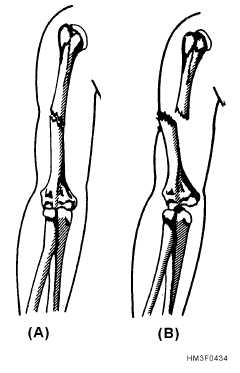bandages, strips of adhesive tape, clothing, or other
suitable materials. If possible, one person should hold
the splints in position while another person fastens
them.
Application
Although splints should be applied snugly, they
should never be tight enough to interfere with the
circulation of the blood.
When you are applying
splints to an arm or a leg, try to leave the fingers or toes
exposed. If the tips of the fingers or toes become blue
or cold, you will know that the splints or bandages are
too tight.
You should examine a splinted part
approximately every half hour and loosen the
fastenings if the circulation appears to be impaired.
Remember that any injured part is likely to swell, and
splints or bandages that are otherwise applied correctly
may later become too tight.
MANAGEMENT OF BONE
INJURIES
LEARNING OBJECTIVE: Select the
appropriate stabilization and treatment
procedure for the management of bone
injuries.
A break in a bone is called a fracture. There are
two main kinds of fractures. A closed fracture is one
in which the injury is entirely internal; the bone is
broken but there is no break in the skin. An open
fracture is one in which there is an open wound in the
tissues and the skin. Sometimes the open wound is
made when a sharp end of the broken bone pushes out
through the flesh; sometimes it is made by an object
such as a bullet that penetrates from the outside.
Figure 4-34 shows closed and open fractures.
Open fractures are more serious than closed
fractures. They usually involve extensive damage to
the tissues and are quite likely to become infected.
Closed fractures are sometimes turned into open
fractures by rough or careless handling of the victim.
It is not always easy to recognize a fracture. All
fractures, whether closed or open, are likely to cause
severe pain and shock; but the other symptoms may
vary considerably. A broken bone sometimes causes
the injured part to be deformed or to assume an
unnatural position. Pain, discoloration, and swelling
may be localized at the fracture site, and there may be a
wobbly movement if the bone is broken clear through.
It may be difficult or impossible for the victim to move
the injured part; if able to move it, there may be a
grating sensation (crepitus) as the ends of the broken
bone rub against each other. However, if a bone is
cracked rather than broken through, the victim may be
able to move the injured part without much difficulty.
An open fracture is easy to recognize if an end of the
broken bone protrudes through the flesh. If the bone
does not protrude, however, you might see the external
wound but fail to recognize the broken bone.
General Guidelines
If you are required to give first aid to a person who
has suffered a fracture, you should follow these general
guidelines:
If there is any possibility that a fracture has been
sustained, treat the injury as a fracture until an
X-ray can be made.
Get the victim to a definitive care facility at the
first possible opportunity. All fractures require
medical treatment.
Do not move the victim until the injured part has
been immobilized by splinting (unless the move
is necessary to save life or to prevent further
injury).
4-46
Figure 4-34.—Fractures: A. Closed; B. Open.

